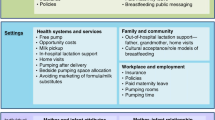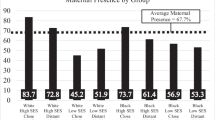Abstract
Background
Despite high initiation rates for mother’s own milk (MOM) provision, MOM feeding at discharge from the neonatal intensive care unit (NICU) drops precipitously and reveals a racial/ethnic disparity. This study sought to identify factors that (1) predict MOM feeding at NICU discharge, and (2) mediate racial/ethnic disparity in MOM feeding at discharge.
Methods
Secondary analysis of prospective cohort study of 415 mothers and their very low birth weight infants. Variables were grouped into five categories (demographics, neighborhood structural, social, maternal health, and MOM pumping). Significant predictors from each category were entered into a multivariable logistic regression model.
Results
Although 97.6% of infants received MOM feedings, black infants were significantly less likely to receive MOM feeding at discharge. Positive predictors were daily pumping frequency, reaching pumped MOM volume ≥500 mL/day by 14 days, and maternal age. Negative predictors were low socioeconomic status (SES) and perceived breastfeeding support from the infant’s maternal grandmother. Low SES, maternal age, and daily pumping frequency mediated the racial/ethnic differences.
Conclusions
Multiple potentially modifiable factors predict MOM feeding at NICU discharge. Importantly, low SES, pumping frequency, and maternal age were identified as the mediators of racial and ethnic disparity. Strategies to mitigate the effects of modifiable factors should be developed and evaluated in future research.
Similar content being viewed by others
Log in or create a free account to read this content
Gain free access to this article, as well as selected content from this journal and more on nature.com
or
Change history
18 September 2019
An amendment to this paper has been published and can be accessed via a link at the top of the paper.
References
March of Dimes. Very low birthweight by race/ethnicity: United States, 2012–2014 Average. http://www.marchofdimes.org/Peristats/ViewSubtopic.aspx?reg=99&top=4&stop=54&lev=1&slev=1&obj=1 (2017).
Lee, H. C. & Gould, J. B. Factors influencing breast milk versus formula feeding at discharge for very low birth weight infants in California. J. Pediatr. 155, 657–62.e1-2 (2009).
Patel, A. L. et al. Impact of early human milk on sepsis and health care costs in very low birthweight infants. J. Perinatol. 33, 514–519 (2013).
Patra, K. et al. NICU human milk dose and 20-month neurodevelopmental outcome in very low birth weight infants. Neonatology 112, 330–336 (2017).
Stuebe, A. M. & Schwarz, E. B. The risks and benefits of infant feeding practices for women and their children. J. Perinatol. 30, 155–162 (2010).
Stewart, S. L. et al. Disparities in ovarian cancer survival in the United States (2001–2009): findings from the CONCORD-2 study. Cancer 123(Suppl. 24), 5138–5159 (2017).
Philipp, B. L., Brown, E. & Merewood, A. Pumps for peanuts: leveling the field in the neonatal intensive care unit. J. Perinatol. 20, 249–250 (2000).
Sisk, P. M., Lovelady, C. A., Dillard, R. G. & Gruber, K. J. Lactation counseling for mothers of very low birth weight infants: effect on maternal anxiety and infant intake of human milk. Pediatrics 117, e67–e75 (2006).
Pineda, R. G. Predictors of breastfeeding and breastmilk feeding among very low birth weight infants. Breastfeed. Med. 6, 15–19 (2011).
Hoban, R. et al. Goals for human milk feeding in mothers of very low birth weight infants: how do goals change and are they achieved during the NICU hospitalization? Breastfeed. Med. 10, 305–311 (2015).
Nommsen-Rivers, L. A., Chantry, C. J., Peerson, J. M., Cohen, R. J. & Dewey, K. G. Delayed onset of lactogenesis among first-time mothers is related to maternal obesity and factors associated with ineffective breastfeeding. Am. J. Clin. Nutr. 92, 574–584 (2010).
Dewey, K. G., Nommsen-Rivers, L. A., Heinig, M. J. & Cohen, R. J. Risk factors for suboptimal infant breastfeeding behavior, delayed onset of lactation, and excess neonatal weight loss. Pediatrics 112(Part 1), 607–619 (2003).
Lau, C., Hurst, N. M., Smith, E. O. & Schanler, R. J. Ethnic/racial diversity, maternal stress, lactation and very low birthweight infants. J. Perinatol. 27, 399–408 (2007).
Furman, L., Minich, N. & Hack, M. Correlates of lactation in mothers of very low birth weight infants. Pediatrics 109, e57 (2002).
Sisk, P. M., Quandt, S., Parson, N. & Tucker, J. Breast milk expression and maintenance in mothers of very low birth weight infants: supports and barriers. J. Hum. Lact. 26, 368–375 (2010).
Fleurant, E. et al. Barriers to human milk feeding at discharge of very-low-birth-weight infants: maternal goal setting as a key social factor. Breastfeed. Med. 12, 20–27 (2017).
Sisk, P. M., Lovelady, C. A., Dillard, R. G., Gruber, K. J. & O’Shea, T. M. Maternal and infant characteristics associated with human milk feeding in very low birth weight infants. J. Hum. Lact. 25, 412–419 (2009).
Li, R. & Grummer-Strawn, L. Racial and ethnic disparities in breastfeeding among United States infants: Third National Health and Nutrition Examination Survey, 1988-1994. Birth 29, 251–257 (2002).
Tenfelde, S. M., Finnegan, L., Miller, A. M. & Hill, P. D. Risk of breastfeeding cessation among low-income women, infants, and children: a discrete time survival analysis. Nurs. Res. 61, 86–95 (2012).
Riley, B. S. et al. Barriers to human milk feeding at discharge of VLBW infants: evaluation of neighborhood structural factors. Breastfeed. Med. 11, 335–342 (2016).
Burdette, A. M. Neighborhood context and breastfeeding behaviors among urban mothers. J. Hum. Lact. 29, 597–604 (2013).
Anthopolos, R., Kaufman, J. S., Messer, L. C. & Miranda, M. L. Racial residential segregation and preterm birth: built environment as a mediator. Epidemiology 25, 397–405 (2014).
Hoban, R. et al. Milk volume at 2 weeks predicts mother’s own milk feeding at neonatal intensive care unit discharge for very low birthweight infants. Breastfeed. Med. 13, 135–141 (2018).
Hartmann, P. & Cregan, M. Lactogenesis and the effects of insulin-dependent diabetes mellitus and prematurity. J. Nutr. 131, 3016S–3020S (2001).
Hill, P. D., Aldag, J. C. & Chatterton, R. T. Effects of pumping style on milk production in mothers of non-nursing preterm infants. J. Hum. Lact. 15, 209–216 (1999).
van Buuren, S. Multiple imputation of discrete and continuous data by fully conditional specification. Stat. Methods Med. Res. 16, 219–242 (2007).
Graham, J. W., Olchowski, A. E. & Gilreath, T. D. How many imputations are really needed? Some practical clarifications of multiple imputation theory. Prev. Sci. 8, 206–213 (2007).
Muthen, B. Applications of Causally Defined Direct and Indirect Effects in Mediation Analysis Using SEM in Mplus (Muthén & Muthén, Los Angeles, 2011).
Omarsdottir, S. et al. Predictors of sustained maternal milk feeds in extremely preterm infants. J. Perinatol. 35, 367–372 (2015).
Meier, P. P., Patel, A. L., Hoban, R. & Engstrom, J. L. Which breast pump for which mother: an evidence-based approach to individualizing breast pump technology. J. Perinatol. 36, 493–499 (2016).
Meier, P. P., Johnson, T. J., Patel, A. L. & Rossman, B. Evidence-based methods that promote human milk feeding of preterm infants: an expert review. Clin. Perinatol. 44, 1–22 (2017).
Grassley, J. & Eschiti, V. Grandmother breastfeeding support: what do mothers need and want? Birth 35, 329–335 (2008).
McKinney, C. O., et al. Racial and ethnic differences in breastfeeding. Pediatrics 138, e20152388 (2016).
Rossman, B., Meier, P. P., Janes, J. E., Lawrence, C. & Patel, A. L. Human Milk provision experiences, goals, and outcomes for teen mothers with low-birth-weight infants in the neonatal intensive care unit. Breastfeed. Med. 12, 351–358 (2017).
Grassley, J. S., Spencer, B. S. & Law, B. A grandmothers’ tea: evaluation of a breastfeeding support intervention. J. Perinat. Educ. 21, 80–89 (2012).
Lee, H. J., Ilo, I. T., McCollum, K. F. & Culhane, J. F. Racial/ethnic differences in breastfeeding initiation and duration among low-income, inner-city mothers. Soc. Sci. Q. 90, 1251–1271 (2009).
Rasmussen, K. M. et al. New opportunities for breastfeeding promotion and support in WIC: review of WIC food packages, improving balance and choice. J. Nutr. Educ. Behav. 49(Suppl. 2), S197–S201.e1 (2017).
Washio, Y. et al. Incentive-based intervention to maintain breastfeeding among low-income Puerto Rican mothers. Pediatrics 139, e20163119 (2017).
Relton, C. et al. Effect of financial incentives on breastfeeding: a cluster randomized clinical trial. JAMA Pediatr. 172, e174523 (2018).
Parker, M. G. & Patel, A. L. Using quality improvement to increase human milk use for preterm infants. Semin. Perinatol. 41, 175–186 (2017).
Acknowledgements
Thank you to the patients and families who participated in this research. The research reported in this publication was supported by the Eunice Kennedy Shriver National Institute of Child Health and Human Development of the National Institutes of Health under Award Number R03HD081412. The content is solely the responsibility of the authors and does not necessarily represent the official views of the National Institutes of Health.
Author information
Authors and Affiliations
Contributions
A.L.P. conceptualized and designed the study, coordinated and supervised data collection, drafted the initial manuscript, and reviewed and revised the manuscript. M.E.S., R.H., and H.B. supervised data collection, carried out the initial analyses, and reviewed and revised the manuscript. T.J.J. and J.L.E. supervised data collection and reviewed and revised the manuscript. E.F. and B.R. made substantial contributions to data collection. P.P.M. conceptualized and designed the study, coordinated and supervised data collection, and revised the manuscript for important intellectual content. All authors approved the final manuscript as submitted.
Corresponding author
Ethics declarations
Competing interests
The authors declare no competing interests.
Additional information
Publisher’s note: Springer Nature remains neutral with regard to jurisdictional claims in published maps and institutional affiliations.
Supplementary information
Rights and permissions
About this article
Cite this article
Patel, A.L., Schoeny, M., Hoban, R. et al. Mediators of racial and ethnic disparity in mother’s own milk feeding in very low birth weight infants. Pediatr Res 85, 662–670 (2019). https://doi.org/10.1038/s41390-019-0290-2
Received:
Revised:
Accepted:
Published:
Issue date:
DOI: https://doi.org/10.1038/s41390-019-0290-2
This article is cited by
-
Postpartum Health Disparities During the Birth Hospitalization in the United States: A Scoping Review
Journal of Racial and Ethnic Health Disparities (2025)
-
Leveraging mHealth and a milk expression frequency biomarker during postpartum to prolong lactation among parents of critically ill infants: a pilot study
Journal of Perinatology (2023)
-
Early pumping frequency and coming to volume for mother’s own milk feeding in hospitalized infants
Journal of Perinatology (2023)
-
Transmission of negative biases through social commentary included in neonatal intensive care unit progress notes
Journal of Perinatology (2023)
-
Study protocol for reducing disparity in receipt of mother’s own milk in very low birth weight infants (ReDiMOM): a randomized trial to improve adherence to sustained maternal breast pump use
BMC Pediatrics (2022)



